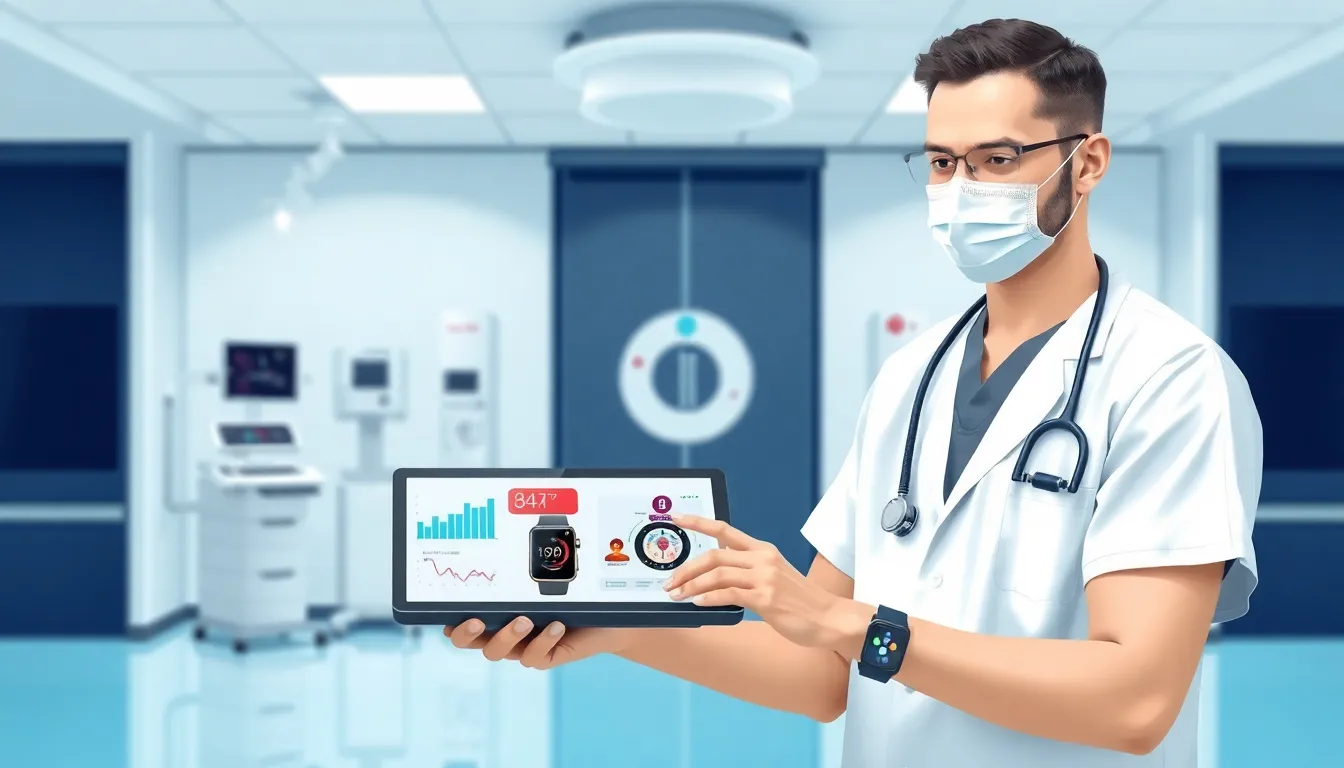In a world where your fridge can remind you to buy milk, it’s no surprise that healthcare is jumping on the tech bandwagon. Enter the Internet of Medical Things (IoMT), where devices are not just smart but downright genius. Imagine a future where your heart monitor sends alerts to your doctor faster than you can say “I need a check-up.”
Table of Contents
ToggleOverview of Internet of Medical Things (IoMT)
The Internet of Medical Things (IoMT) consists of interconnected medical devices and applications that collect, transmit, and analyze health data. This technology streamlines healthcare by enhancing communication between patients and providers. Smart devices, including wearable sensors and remote monitoring systems, gather real-time data, providing healthcare professionals with timely insights.
Real-time monitoring improves patient outcomes significantly. For example, heart rate monitors alert physicians instantly if a patient’s condition deteriorates. Integration of IoMT enhances proactive care management by allowing remote assessments and quicker responses to health issues.
Data security remains a critical concern. Medical devices often handle sensitive patient information, necessitating robust cybersecurity measures. Compliance with regulations, such as HIPAA, is essential for protecting patient privacy and maintaining trust.
Large-scale adoption of IoMT leads to better data analytics. Insights derived from collected data empower healthcare providers to make informed decisions, optimize treatment plans, and reduce hospital readmissions. Hospitals increasingly rely on these technologies to enhance overall efficiency and patient satisfaction.
Implementing IoMT involves various challenges. Connectivity issues, device interoperability, and regulatory hurdles can complicate deployment. However, as the healthcare industry embraces the digital transformation, solutions for these challenges continue to evolve.
Patients experience more proactive care through IoMT applications, fostering better health management. Healthcare providers can tailor treatments based on individual patient data, ultimately leading to personalized care. As innovation continues in this space, the potential for IoMT to revolutionize healthcare is immense.
Key Components of IoMT

Key components of the Internet of Medical Things include wearable devices and connected medical equipment. These elements play critical roles in enhancing patient care and streamlining healthcare processes.
Wearable Devices
Wearable devices encompass various health-monitoring technologies. Examples include smartwatches, fitness trackers, and continuous glucose monitors. These devices collect data on vital signs, activity levels, and health conditions in real time. Healthcare providers can access this information, enabling proactive care management. Patients benefit from the convenience of tracking their health metrics easily. Remote monitoring through wearable devices improves communication between patients and providers, driving personalized care.
Connected Medical Equipment
Connected medical equipment includes devices such as smart infusion pumps, telehealth systems, and digital imaging systems. These tools facilitate the exchange of health data among professionals and patients. Sharing information enhances decision-making and optimizes treatment plans. Real-time access to patient data ensures timely interventions and reduces the risk of complications. Moreover, this equipment supports efficient inventory management in healthcare settings. Reliable connections between devices streamline operations and improve overall patient outcomes.
Benefits of IoMT
The Internet of Medical Things (IoMT) provides significant advantages in healthcare, particularly for patient monitoring and data management.
Improved Patient Monitoring
Real-time patient monitoring enhances healthcare delivery. Connected devices track vital signs continuously, delivering data to healthcare providers instantly. Immediate alerts about critical changes in a patient’s condition facilitate prompt interventions. Providers can adjust treatment plans swiftly based on this information, leading to better outcomes. Increased engagement among patients occurs as they monitor their health status through wearable technology. Enhanced visibility into patient conditions enables proactive management, reducing hospital admissions. Studies show that hospitals utilizing IoMT see up to a 30% decrease in readmission rates.
Enhanced Data Management
Data management improves through the integration of IoMT. The ability to collect and analyze vast amounts of health data streamlines processes significantly. Providers access patient records easily, leading to more informed clinical decisions. Centralized data storage allows for better organization and retrieval, minimizing errors. Furthermore, automated analytics identify trends over time, enhancing treatment strategies. Reports illustrate that hospitals using IoMT solutions report a 40% increase in data accuracy. Compliance with regulations is more manageable, as data is securely transmitted and stored.
Challenges in Implementing IoMT
Implementing the Internet of Medical Things (IoMT) faces several challenges that impact its adoption in healthcare.
Security Concerns
Security concerns pose significant risks for IoMT. Cybersecurity threats, such as data breaches and hacking, can compromise sensitive patient information. According to experts, around 60% of healthcare organizations experienced a cyber incident in 2022. Compliance with regulations like HIPAA demands robust security measures to protect data integrity and patient privacy. Healthcare providers must invest in advanced cybersecurity solutions that include encryption, access controls, and continuous monitoring. Training staff on cybersecurity best practices enhances awareness and capability to prevent potential threats. Trust in IoMT systems depends on the assurance of data protection.
Interoperability Issues
Interoperability issues create barriers for seamless data exchange among medical devices. Many devices use different standards and protocols, complicating effective communication between systems. A lack of standardization restricts healthcare providers’ ability to integrate IoMT solutions into existing infrastructure. Industry estimates suggest that improving interoperability could lead to a 25% increase in operational efficiency. Collaborating with manufacturers to adopt common standards encourages better integration and communication. Healthcare stakeholders must prioritize developing unified systems that support interoperability, facilitating comprehensive patient care. Addressing these issues remains essential for maximizing the potential of IoMT in healthcare environments.
Future Trends in IoMT
Emerging technologies will continue to drive innovation in the Internet of Medical Things (IoMT). Predictive analytics emerges as a key trend, leveraging AI to analyze health data and forecast patient outcomes. This approach aims to identify health issues early, moving healthcare from reactive to proactive strategies.
Data interoperability stands out in the future of IoMT. Improved standards and protocols enable seamless sharing of patient information among devices, enhancing care continuity. This shift could increase operational efficiency by 25%, ensuring healthcare providers make informed decisions.
Telehealth integration is another crucial trend. The rise of remote monitoring tools supports virtual consultations, allowing for real-time patient assessments and follow-ups. This trend expands access to care, particularly for patients in rural areas.
Cybersecurity advancements will also shape IoMT’s trajectory. Increased investment in robust security measures aims to address rising cyber threats, with around 60% of healthcare organizations reporting incidents. Adopting advanced technologies like blockchain can enhance data protection and ensure compliance with regulations.
Wearable technology will continue to evolve, with devices collecting even more comprehensive health data. Enhanced capabilities will provide healthcare providers with deeper insights into patients’ health and facilitate personalized treatment plans. Wearables foster greater patient engagement, empowering individuals to take control of their health.
Lastly, the focus on patient-centered care is expected to drive further developments in IoMT. Healthcare systems will prioritize the integration of tools that prioritize patient preferences and experiences. This alignment will enhance overall care quality and satisfaction, reinforcing the value of IoMT in modern healthcare.
The Internet of Medical Things is transforming healthcare by enhancing patient monitoring and data management. With real-time data collection and analysis, healthcare providers can deliver proactive care and improve outcomes. Despite challenges like security concerns and interoperability issues, the potential for IoMT to revolutionize patient care remains significant.
As technology advances, the integration of AI and predictive analytics will further empower healthcare professionals to make informed decisions. The focus on patient-centered care will ensure that innovations align with individual needs and preferences. Embracing these trends will be crucial for maximizing the benefits of IoMT and fostering a more efficient and effective healthcare system.






